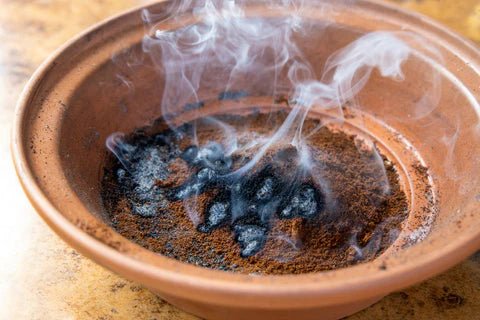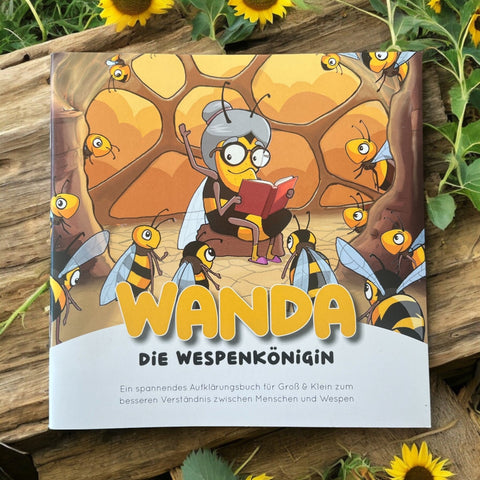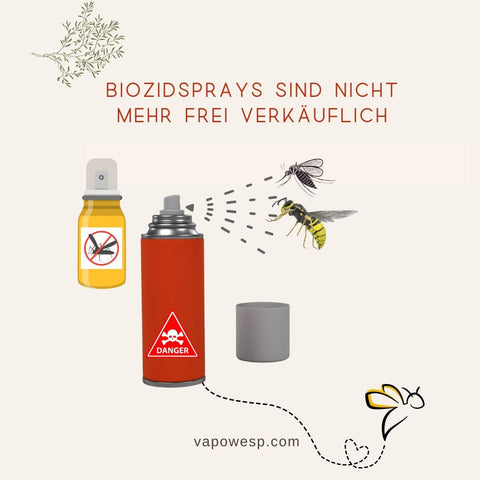Sustainable methods for repelling wasps:
A comparison between coffee grounds and beekeeper smoker
Summer brings not only sunny days and blooming gardens but also the inevitable presence of wasps.
Many people are looking for effective and at the same time environmentally friendly methods to repel annoying insects. An interesting and sustainable method is smoking coffee grounds.
In this blog post, we explain the mode of action of this method and compare it with the technique that beekeepers worldwide have been using for hundreds of years to distract bees with a smoker while working at the beehive.
The mode of action of coffee grounds in repelling wasps
Coffee grounds are a versatile natural product that is often simply thrown away in many households. However, they can be reused in many ways, including to repel wasps. The method is simple and efficient:
- Why can coffee grounds smolder and smoke?: The coffee bean is - like the cocoa bean, for example - oily. Therefore, coffee grounds can be ignited with a butane lighter. A match is not sufficient because the heat from the match is not enough, and the coffee grounds must be ignited in one spot for at least 8-10 seconds so that the oil in the coffee grounds gets properly hot. Only then does it start to smolder.
-
Smoking the coffee grounds: Place the dried coffee grounds in a fireproof dish and light it. The coffee grounds smolder and produce smoke. Wasps visually detect these smoke particles in the air and perceive them as a danger. Since all insects avoid smoke, they instinctively avoid areas around smoke sources.
Why does this method work?
The smoke produced by burning coffee grounds is perceived by wasps as a danger. Unlike chemical insecticides, the smoke is not harmful to the environment and poses no danger to humans or pets. The coffee ground smoke acts as a natural repellent that drives away wasps without killing them.
Wasp sprays are highly toxic; when people inhale these sprays, it is also unhealthy for humans. Wasp sprays also have a wide dispersion - the toxins settle on surfaces, leaves, grass, or stones, and as soon as other insects come into contact with them (such as bees or ladybugs), these toxins also harm these beneficial insects.
Comparison with the beekeeper smoker
Beekeepers use a similar method to distract or drive away bees: the smoker.
The smoker is a special device that produces smoke, which signals to the bees that there might be a forest fire nearby. This causes the bees to retreat into their hive and focus on defending their home instead of attacking the beekeeper or fleeing.
Functioning of the beekeeper's smoker
- Filling and lighting the smoker: The smoker is filled with natural materials such as wood chips, straw, or cardboard and lit.
- Generation of smoke: Air is pumped into the smoker, continuously producing smoke.
-
Application of the smoke: The beekeeper carefully directs the smoke into the beehive to calm the bees.
Differences and similarities
- Active ingredient:�Both the fumigated coffee powder and the smoke produced in a�smoker�by fumigation powder, wood wool, etc., trigger the survival instinct of wasps and bees.
- Goal: The coffee powder smoke is intended to repel wasps, while the smoker smoke serves to calm bees and prevent aggressive behavior.
- Sustainability: Both methods are environmentally friendly as they are based on natural materials and do not use harmful chemicals.
Questions:
1.�CoCan any type of coffee powder be used?
Is dried coffee grounds also possible?
The essential oils are completely washed out here - therefore, dried coffee grounds can no longer smolder and be used for fumigation.
2.�Can coffee powder be burned in any container?
The smoldering coffee powder mixture can become very hot if it smolders for a long time. Therefore, you should definitely use a fireproof container - ashtrays or glass containers cannot withstand this heat. If you use a container without an insulating bottom layer, you risk a burn mark on the table.
The VapoWesp incense box was specially designed so that the incense container is hung into a lid holder, allowing the incense vessel to float freely.
If used correctly, no burn marks can occur this way.
You can also watch how everything is set up and used here in our short�YouTube video�.
3. Does burnt coffee powder repel only wasps or also other insects like mosquitoes or gnats?
Since all insects flee from smoke, the smoking method has also proven effective in repelling mosquitoes and gnats. In earlier years, when no biocide products or insecticides were available, for example, bedbugs were smoked out or horse stables were freed from flies by smoking.
For use as protection against mosquitoes, it is best to place the incense container on the ground, as many mosquitoes especially like to bite legs/feet in the evening hours. The smoke rises anyway, so you are best protected when the incense container is placed on the ground.

4. Do mosquito coils / incense coils work better than burning coffee grounds against wasps and mosquitoes?
So-called mosquito coils / incense coils produce smoke that is additionally enriched with biocides. These toxins are highly toxic and should under no circumstances be inhaled by humans, especially not by toddlers, babies, or animals.
The warning labels on each package indicate which ingredients are released when lighting the mosquito coil / smoke coils. In some cases, it is also described that these products are so toxic that they MUST NOT be disposed of in regular household waste and that the ingredients must not enter the groundwater. Additionally, the smoke from these smoke coils / mosquito coils smells very unpleasant.
Unlike these biocide products that are meant to kill insects, the method of burning coffee grounds only keeps wasps, mosquitoes, and other insects away and is completely harmless to humans, insects, or nature.
Burning coffee grounds is a simple, cost-effective, and sustainable method to repel wasps. It offers an environmentally friendly alternative to chemical insecticides while protecting nature and our health.
Compared to the technique of beekeepers, it is evident that smoke is generally an effective method to influence insect behavior.
Both methods use the natural instincts and reactions of insects to smoke to achieve the desired behavior, whether it is repelling wasps or calming bees.
Mosquito coils or smoke coils are enriched with biocides and kill insects, whether they are beneficial or harmful.
In a time when sustainability is becoming increasingly important, such environmentally friendly approaches are not only more effective but also more responsible in dealing with our environment.
Try it out and experience for yourself how simple and effective burning coffee grounds to repel wasps, mosquitoes, and gnats can be!





